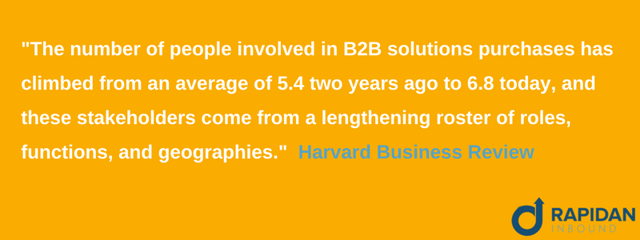
In today's B2B buying process, content marketing plays an essential role. According to Accenture, 94% of buyers use online research at some point in the buying process.
Many sellers create marketing content like blog posts, videos, and infographics for purely inbound purposes - to get found by potential buyers in google searches and social media posts and then to nurture inbound leads through the buying process.
But an effective business development process relies upon multiple marketing channels, of which inbound marketing is just one. The best B2B sellers take advantage of their marketing content to help fuel their other marketing channels like referrals, cross-selling, paid advertising and outbound prospecting.
Another thing to keep in mind is the fact that buying processes are lengthening and more people are involved. According to the Harvard Business Review, "the number of people involved in B2B solutions purchases has climbed from an average of 5.4 two years ago to 6.8 today, and these stakeholders come from a lengthening roster of roles, functions, and geographies."

Strategically delivering content to all of the stakeholders in a B2B buying process can't be accomplished by inbound marketing alone. You need to identify the typical players in your buyer's decision-making process and deliver content to them that gets their attention and makes it easier for them to buy from you.
Here are 3 strategic ways to get your content in front of all the stakeholders that influence purchase decisions.
Using Content To Get The Economic Buyer's Attention
An economic buyer is one from whose budget the purchase will be made. Typically a CEO or Division Head, an economic buyer has the power to say no when everyone else says yes and to say yes when everyone else says no.
In today's B2B buying environment, this person is increasingly interested in risk management - a bad purchase decision carries consequences. While it's important to get on the economic buyer's radar, remember that they rely on stakeholder consensus to reduce risk in the purchase decision. You'll have to get everyone else on board too.
A strategic way to get the economic buyer's attention is to deliver content that shows both the benefits of solving a problem and the consequences of not solving it properly. And you have to do it quickly - economic buyers aren't going to read 3-page emails extolling the virtues of your company.
Case Studies are an excellent way of quickly demonstrating value to an economic buyer like a CEO or division head. Send a very brief email that introduces the results of the case study and its relevance to that economic buyer. For instance, you might share a case study of a competitor or someone in a similar industry. Make share to include specifics on money saved, performance improvements and other results that correspond with your buyers wants and needs.
For these emails, we recommend that you don't put your case studies
Remember, the goal here is to introduce awareness to the economic buyers of how you've helped other people solve problems that she probably has.
Using Content To Educate User Buyers
User buyers are the people who will use your solution if they buy from you. If you're an accounting consultant, a CFO will likely be your economic buyer. But the controller and her team are the people who will be working with you to get through the audit.
It's very important to understand the needs of the users and how you can help them "win" as they implement your solution. With an increasing emphasis on risk management in the buying process, it's unlikely that an economic buyer will say yes without the approval of the user buyer(s.)
The first step in helping them "win" is to educate them on a problem that they face and potential solutions for that problem. This type of content accomplishes 2 purposes:
-
You help the user buyers look good internally by helping them learn about the problem you solve so that they can proactively address it in their organization. It's important to keep in mind that they need objective information - now is not the time for a sales pitch.
-
You start developing relationships with people who can potentially serve as a coach or champion in the buying process.
B2B buying cycles are lengthening. Educational content can get you on a buying shortlist relatively early in the buying process, where you have more potential to influence the outcome.
For this content, it's not a bad idea to use a landing page to gather a little bit of information on the buyer. A landing page can also serve as a qualification stage in your buying process.
This is a bottom-up strategy designed to complement the top-down strategy with the decision-maker.
Using Content To Upsell Existing Customers
An often under-utilized strategy is to use content to upsell your current customers. What's a better opportunity than to sell to someone with whom you've already had a successful relationship?
These people already know you, so will be receptive to your content as long as you don't overdo it. Share blog posts with them to educate them on problems and opportunities they may not have considered. Share case studies with them to show how they can benefit by successfully addressing an issue.
Empower your customer service team to use content as they work with customers to make them better at their jobs. In many cases, it makes sense to give an existing customer a discount or other incentive to buy more from you. This will make them more amenable to referring business to you and/or providing a testimonial or case study.
These are just a few of the ways you can get relevant marketing content in front of the stakeholders in your buying process. The important takeaway is that there are multiple stakeholders involved in the decision to buy your solutions. You have to be strategic and creative to get the right content in front of the various stakeholders in the buying process. Growth stack technology (we recommend HubSpot) can make your outreach more effective by using lead intelligence to personalize your content. The B2B buying process is evolving rapidly and you need to adapt your marketing to interact with buyers on their own terms.








